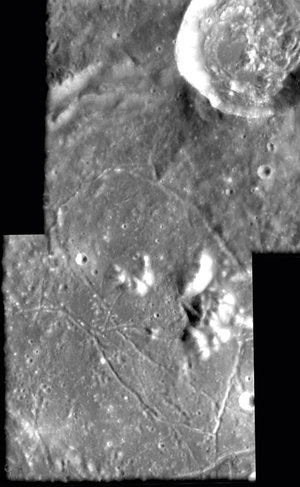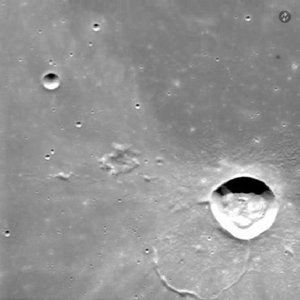Gruithuisen: non-mare volcanism in Procellarum
This image, taken by the advanced Moon Imaging Experiment (AMIE) on board ESA's SMART-1 spacecraft, shows the Gruithuisen area on the Moon.
AMIE obtained this sequence on 1 January 2006, from a distance of about 2154 kilometres from the surface, with a ground resolution of 195 metres per pixel. The area shown in the image is centred at a latitude of 34.8º North and longitude 40º West.
The prominent bowl-shaped crater close to the left edge of the image is Gruithuisen B. Gruithuisen itself is just visible at the right edge of the image. The mountains visible in the area are called Mons Gruithuisen.
It is possible to note the large number of similar sized craters to the right of the centre of the image. They are so-called secondary craters, produced by ejecta particles from a large impact which fell back to the Moon.
According to Head and Mc Cord (1978), the Gruithuisen dome on the Moon represents volcanic features of Imbrian age which are different in shape and in 'spectral fingerprints' (mineralogical nature). These features are not of a 'mare' nature (a mare is a large lava plain) and they are of 'extrusive' origin, that is, they are generated by volcanic material flowing out from the surface and then crystallising.
The composition, morphology, and age relationships of the domes indicate that the non-mare extrusive volcanism in the northern Procellarum region of the Moon continued until about 3.3 to 3.6 thousand million years ago and was partially contemporaneous with the emplacement of the main sequence of mare deposits.
In 1999 Chevrel, Pinet and Head found that spectral characteristics of the dome and the dome-like unit are clearly different from those of highlands and of the surrounding mare basalts. The spectral identification of a widespread dome-like unit suggests that the specific style of eruption deduced for the formation of the domes (that is, viscous flows of possible more silica composition) might have occurred on a regional scale in this part of the Moon, prior to the Iridum event about 3.8 thousand million years ago. This volcanic style appears to be more widespread in the early part of lunar history than previously thought.
The area is named after Franz von Gruithuisen, a 19th century German astronomer (1774 - 1852). Gruithuisen spent a lot of his time observing the Moon and actually thought it is inhabited. Already in 1840 he proposed that the lunar craters are the result of meteoritic impacts rather than volcanoes, as was commonly believed up into the 20th century.
For more information
Bernard H. Foing, ESA SMART-1 Project Scientist
Email: bernard.foing @ esa.int
Jean-Luc Josset, AMIE Principal Investigator
SPACE-X Space Exploration Institute
Email: jean-luc.josset @ space-x.ch






















